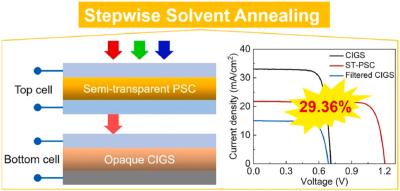Researchers from China's Northwest Normal University, Xidian University and Xi'an Shiyou University have developed a four-terminal perovskite-CIGS tandem solar cell based on a top semi-transparent perovskite device with an efficiency of 21.26% and a high bifaciality factor of 92.2%. The scientists used a solvent-annealing strategy to produce a perovskite film with full coverage, larger grains, superior crystallinity and free of detectable lead iodide impurity.
The team fabricated a four-terminal (4T) tandem solar cell based on a top semi-transparent perovskite device and a bottom cell relying on copper-indium-gallium-selenide (CIGS). The scientists used a stepwise dimethyl sulfoxide (DMSO) solvent-annealing method to improve the crystallinity of the perovskite film used in the perovskite top cell and fabricated films with a wide bandgap of 1.68 eV via two consecutive heating steps: annealing at 100 C and then 80 C.
The scientists explained that the first step is intended to induce fast nucleation and efficient growth of film grains with high crystallinity, while the second step is aimed to release DMSO molecules preventing the sublimation of volatile organic halide species, thus avoiding lead(ii)iodide (PbI2) impurity phase growth.
Further electrochemical impedance spectroscopy (EIS) analysis reportedly showed that the stepwise solvent-annealing strategy was able to produce a perovskite film with larger grains, higher crystallinity, and purer phase than a control sample produced using the traditional solvent-annealing method.
The research group built the top perovskite cell with a substrate made of indium tin oxide (ITO) and glass, an electron transport layer (ETL) based on tin oxide (SnO2), the optimized perovskite absorber, a Spiro-OMeTAD hole transport layer (HTL), a molybdenum oxide (MoOx) layer, and a semi-transparent back contact made of indium zinc oxide (IZO).
The cell achieved a power conversion efficiency of 21.26%, an open-circuit voltage of 1.210 V, a short-circuit current density of 21.43 mA/cm2, and a fill factor of 0f 82.0%. It was then combined with a bottom CIGS solar cell with an efficiency of 18.29%, with this efficiency value decreasing to 7.89 % after the bottom device is filtered by the semi-transparent perovskite cell.




